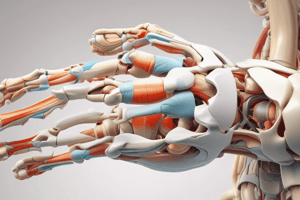Podcast
Questions and Answers
What type of motion is described as linear movements where bones slide?
What type of motion is described as linear movements where bones slide?
- Uniaxial motion
- Biaxial motion
- Non-axial motion (correct)
- Multi-axial motion
Which joint type allows movement in one plane?
Which joint type allows movement in one plane?
- Non-axial motion
- Uniaxial motion (correct)
- Biaxial motion
- Multi-axial motion
Which of the following joints allows for movement in three planes?
Which of the following joints allows for movement in three planes?
- Finger joints
- Shoulder joint (correct)
- Knee
- Metacarpophalangeal joint
A sprain refers to stretching or tearing of a muscle.
A sprain refers to stretching or tearing of a muscle.
What is a partial dislocation called?
What is a partial dislocation called?
What is bursitis?
What is bursitis?
What condition results from inadequate ossification of bones?
What condition results from inadequate ossification of bones?
Which of the following is known as degenerative arthritis?
Which of the following is known as degenerative arthritis?
What is the primary cause of gouty arthritis?
What is the primary cause of gouty arthritis?
Rheumatoid arthritis only affects men.
Rheumatoid arthritis only affects men.
The embryonic tissue that gives rise to all bones, cartilages, and connective tissues of the body is called ______.
The embryonic tissue that gives rise to all bones, cartilages, and connective tissues of the body is called ______.
What type of ligament is also called capsular ligaments?
What type of ligament is also called capsular ligaments?
The condition known as ______ results in inflammation of the synovial membrane.
The condition known as ______ results in inflammation of the synovial membrane.
Which joint condition may require arthroscopic surgery?
Which joint condition may require arthroscopic surgery?
What are bulging and herniated discs caused by?
What are bulging and herniated discs caused by?
Flashcards are hidden until you start studying
Study Notes
Classification of Joints
- Non-axial motion: Bones slide in linear movements (e.g., vertebrocostal, sacroiliac, intercarpal joints).
- Uniaxial motion: Movement occurs in one plane (e.g., finger joints, elbow, knee).
- Biaxial motion: Movement occurs in two planes (e.g., metacarpophalangeal joint, occipital condyles to atlas).
- Multi-axial motion: Movement occurs in three planes (e.g., shoulder joint, hip joint).
Fibrous Joints
- Sutures: Immovable fibrous joints found in the skull.
- Syndesmoses: Slightly movable fibrous joints where bones are held together by ligaments (e.g., distal tibiofibular joint).
- Gomphoses: Specialized fibrous joints that anchor teeth to their sockets (e.g., periodontal ligament).
Ligaments
- Intrinsic ligaments: Also known as capsular ligaments, these are thickenings within the joint capsule, forming parallel bundles of fibers.
- Extrinsic ligaments: These ligaments are separate from the joint capsule, potentially passing outside (extracapsular) or inside (intracapsular) the capsule.
Development of Joints
- Joints form during embryonic development in conjunction with bone formation and growth.
- Mesenchyme, the embryonic tissue, differentiates into all bones, cartilages, and connective tissues of the body.
Common Joint Injuries
- Sprain: Stretching or tearing of a ligament across the joint capsule.
- Dislocation (luxation): Occurs when reinforcing structures fail to protect a joint from extreme stresses, causing the articulating surfaces to be forced out of position.
- Subluxation: Partial dislocation.
- Bursitis: Inflammation of the bursa.
- Tendonitis: Inflammation of the tendon.
- Synovitis: Inflammation of the synovial membrane.
- Osteopenia and osteoporosis: Inadequate ossification of bone, starting around age 30-40. Osteopenia is the initial decline in bone mass, followed by osteoporosis if the reduction is significant.
- Arthritis: Inflammatory or degenerative joint disease characterized by thickened synovial membranes and decreased fluid production, leading to friction and pain.
Types of Arthritis
- Osteoarthritis (degenerative arthritis): Affects individuals over 60, resulting from wear and tear or genetic collagen issues.
- Rheumatoid arthritis: Autoimmune disease affecting joints on both sides of the body, typically wrists, fingers, knees, feet, and ankles. More common in middle age and women.
- Gouty arthritis: Caused by high uric acid levels in the blood, forming crystals in joints (often the big toe), leading to sudden pain, stiffness, and swelling. More common in men.
Bulging and Herniated Discs
- Bulging disc: Compression of the nucleus pulposus distorts the anulus fibrosus.
- Herniated disc: The nucleus pulposus protrudes through the anulus fibrosus into the vertebral canal.
Studying That Suits You
Use AI to generate personalized quizzes and flashcards to suit your learning preferences.




